
eBook - ePub
Draw Manga
Step-by-Steps, Character Construction, and Projects from the Masters
This is a test
Buch teilen
- 250 Seiten
- English
- ePUB (handyfreundlich)
- Über iOS und Android verfügbar
eBook - ePub
Draw Manga
Step-by-Steps, Character Construction, and Projects from the Masters
Angaben zum Buch
Buchvorschau
Inhaltsverzeichnis
Quellenangaben
Über dieses Buch
This easy, step-by-step art course for beginners teaches the creative techniques behind the popular Japanese manga comic style. Professional manga artists reveal their secrets for drawing individual character elements and creating an effective manga character.
Häufig gestellte Fragen
Wie kann ich mein Abo kündigen?
Gehe einfach zum Kontobereich in den Einstellungen und klicke auf „Abo kündigen“ – ganz einfach. Nachdem du gekündigt hast, bleibt deine Mitgliedschaft für den verbleibenden Abozeitraum, den du bereits bezahlt hast, aktiv. Mehr Informationen hier.
(Wie) Kann ich Bücher herunterladen?
Derzeit stehen all unsere auf Mobilgeräte reagierenden ePub-Bücher zum Download über die App zur Verfügung. Die meisten unserer PDFs stehen ebenfalls zum Download bereit; wir arbeiten daran, auch die übrigen PDFs zum Download anzubieten, bei denen dies aktuell noch nicht möglich ist. Weitere Informationen hier.
Welcher Unterschied besteht bei den Preisen zwischen den Aboplänen?
Mit beiden Aboplänen erhältst du vollen Zugang zur Bibliothek und allen Funktionen von Perlego. Die einzigen Unterschiede bestehen im Preis und dem Abozeitraum: Mit dem Jahresabo sparst du auf 12 Monate gerechnet im Vergleich zum Monatsabo rund 30 %.
Was ist Perlego?
Wir sind ein Online-Abodienst für Lehrbücher, bei dem du für weniger als den Preis eines einzelnen Buches pro Monat Zugang zu einer ganzen Online-Bibliothek erhältst. Mit über 1 Million Büchern zu über 1.000 verschiedenen Themen haben wir bestimmt alles, was du brauchst! Weitere Informationen hier.
Unterstützt Perlego Text-zu-Sprache?
Achte auf das Symbol zum Vorlesen in deinem nächsten Buch, um zu sehen, ob du es dir auch anhören kannst. Bei diesem Tool wird dir Text laut vorgelesen, wobei der Text beim Vorlesen auch grafisch hervorgehoben wird. Du kannst das Vorlesen jederzeit anhalten, beschleunigen und verlangsamen. Weitere Informationen hier.
Ist Draw Manga als Online-PDF/ePub verfügbar?
Ja, du hast Zugang zu Draw Manga von im PDF- und/oder ePub-Format sowie zu anderen beliebten Büchern aus Kunst & Kunsttechniken. Aus unserem Katalog stehen dir über 1 Million Bücher zur Verfügung.
Information
Thema
KunstThema
KunsttechnikenPART 1
TUTORIALS

HEAD
Although manga is a very distinct form of artwork, it is based on the fundamental skills of basic figure-drawing and knowledge of anatomy. Too often many beginners launch straight into the more famous aspects of the manga style, such as the exaggerated facial features and the lustrous hair, and upon completing their drawing realize that something does not look quite right. It is very important to have some knowledge about how the overall head of a character is put together, as it forms the “canvas” for the face, allowing you to place facial features accurately. Knowing how to construct a head from first principles will mean that you can effectively portray a character from almost any angle. The human head comes in many different sizes and shapes. However, all heads are formed from a skull, which can essentially be represented by a sphere with a lower jaw.
BUILDING BLOCKS

1. Draw a circle for the upper part of the head. Draw a cross over it, splitting the circle into quarters. The vertical line represents the center line of the head and face. The horizontal line represents the upper eye socket line.

2. Draw curved lines from the sides of the face to the bottom of the vertical line. These lines map out the chin and jaw. Draw another horizontal line in between the eyeline and the point of the chin, roughly equidistant from the two. This helps place the nose.

3. Using these lines as a rough guide for the placement of features, add in the details of the eyes, nose, ears, mouth, and neck. The ears are at a similar level to the eyes and are spaced evenly on the sides of the head. The mouth is approximately halfway between the bottom of the nose and the chin.
USEFUL TIPS

Note that the strength and length of the curve can vary for different faces, depending on how far you extend the vertical center line.
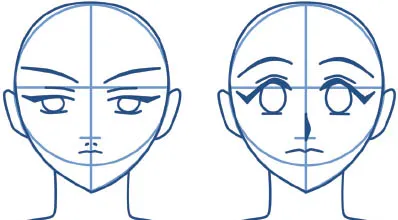
These guidelines are intended as a rough way of placing facial features. Depending on the type of character you are drawing, their features can extend beyond these lines.
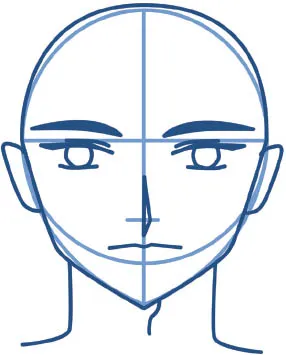
For a male face, make the neck thicker, the eyes narrower, the nose longer, and the jawline more angular. Don’t forget the Adam’s apple!
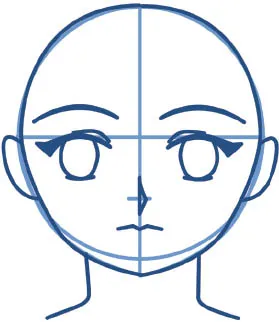
When drawing a child, the lower half of the head is more compact, making all the facial features much closer together. Draw a small, short nose and mouth, but keep the eyes large, as in real life. This conveys a sense of cuteness.
DIFFERENT VIEWS

To draw a side view, start with the forehead, then dip in slightly before drawing the nose. Below the nose, draw another dip into the lips, then chin. Note how the lips and chin are not far from the face’s center line. Also observe the placing of the ear, slightly closer to the back of the head than exactly halfway.

Three-quarter views benefit most from guidelines – think in three dimensions when drawing the center line and eyeline. Take care with the side of the face – draw a slight dip below the temple, rounding out to the cheekbone. The jawline can then be round, sunken, muscular, etc., as appropriate.
OVER TO YOU!
Here are various examples of different characters’ heads from several viewpoints. These characters do not have the same facial proportions, as they range from male to female, young to old. By using the basic model you can ensure all of their features are realistically placed at every angle the head is viewed from.
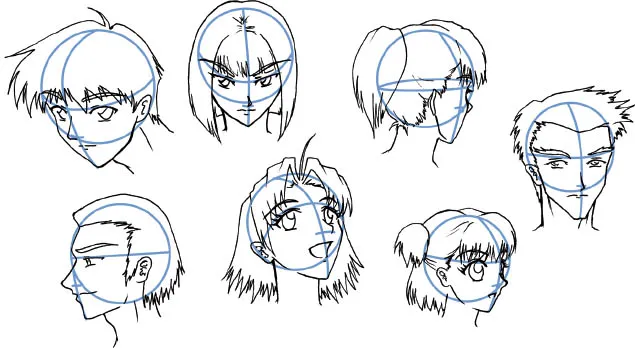
EYES
Large eyes are the most iconic feature of the manga aesthetic. However, there are many different approaches to drawing manga-style eyes, and each approach can radically change the way in which a character is perceived. Manga is all about individuality, so use the following guidance as stepping stones to developing your own unique style.
BUILDING BLOCKS
On the two-dimensional plane, an eye is made up of three sections: the upper line, the ball and the lower line. These three simple parts can be molded into an infinite number of unique styles. Two very different examples are shown below.

1. The upper and lower lines are elongated and flattened. An outside corner has been added and the two lines are almost touching, closing-in the eye. The ball is partly obscured by the upper line, suggesting a hooded or glazed expression.
2. The upper lashes are curving down into the eye rather than upward as expected. This closes the eye in further.
3. A double line has been added inside the lower line for a three-dimensional perspective. A couple of extra lines added above the eye show the eyelid and even the start of the bridge of the nose.
4. Finally, a light source is added to increase the glazed look. The overall impression is of a closed and mysterious character.
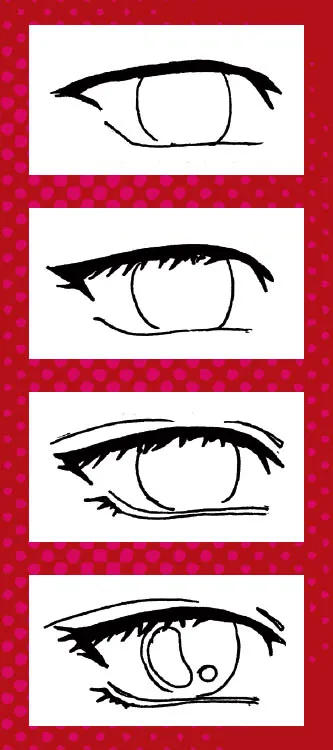
1. The upper line is arched rather than flattened and the lower line shortened. There is still an outside corner, but this time the two lines are further apart. The ball has been expanded upward and is fully visible.
2. A large and simple lash has been added to this eye, rather than the complex lashes of the first example.
3. The double lines are still in place.
4. This time two simple light spots have been chosen. The impre...